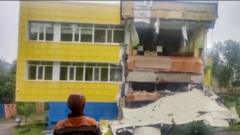As the earth shook near the Kamchatka Peninsula, a tsunami warning was issued, affecting thousands and leading to emergency evacuations across Russia, northern Japan, Hawaii, and the US West Coast. The earthquake, recorded at a powerful 8.8 magnitude, was one of the ten strongest ever documented according to the US Geological Survey. The incident prompted immediate responses in affected areas, although follow-up reports revealed no significant destruction or injuries.
On the Russian front, places like Severo-Kurilsk reported tsunami waves reaching 5 meters (16 feet), though officials lifted the tsunami warning after assessing the damage. In Japan, authorities issued tsunami sirens, leading to evacuations of nearly two million residents, particularly in Iwate Prefecture, although the warnings were soon downgraded. Hawaii experienced smaller waves that led to tense evacuations, but officials noted no dangerous wave activity was soon anticipated.
In the aftermath, the focus turned to recovery, with members of local governments and agencies reiterating safety while residents began returning to their properties. The situation remains fluid, as authorities continue to assess the physical damage while managing alerts in several other Pacific regions, including parts of Canada and South America.
Tsunami warnings and alerts remain active in areas beyond the immediate Pacific, especially in regions such as Peru, where ongoing surveillance measures are in place. Despite global concern, many countries lifted initial alerts, and ongoing assessments continue to ensure public safety amidst the aftermath of this major geological event.
On the Russian front, places like Severo-Kurilsk reported tsunami waves reaching 5 meters (16 feet), though officials lifted the tsunami warning after assessing the damage. In Japan, authorities issued tsunami sirens, leading to evacuations of nearly two million residents, particularly in Iwate Prefecture, although the warnings were soon downgraded. Hawaii experienced smaller waves that led to tense evacuations, but officials noted no dangerous wave activity was soon anticipated.
In the aftermath, the focus turned to recovery, with members of local governments and agencies reiterating safety while residents began returning to their properties. The situation remains fluid, as authorities continue to assess the physical damage while managing alerts in several other Pacific regions, including parts of Canada and South America.
Tsunami warnings and alerts remain active in areas beyond the immediate Pacific, especially in regions such as Peru, where ongoing surveillance measures are in place. Despite global concern, many countries lifted initial alerts, and ongoing assessments continue to ensure public safety amidst the aftermath of this major geological event.




















